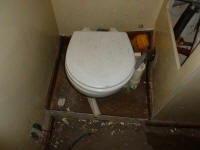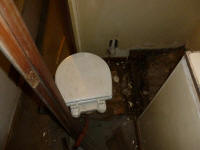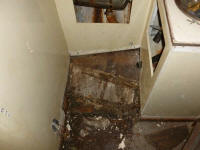
110 Cookson Lane | Whitefield, ME 04353 | 207-232-7600 | tim@lackeysailing.com
The last major disassembly ahead was...the head. I needed to strip out all the old plumbing and fixtures in order to move forward.
After cutting the hoses leading to the toilet, I soon discovered that the platform to which the toilet was secured was mostly rotten, so in short order I'd removed the whole platform with the toilet still attached. I promptly threw the old head away.
Lurking behind the cabinetry was this stainless steel holding tank. I'd noticed the hose exiting the bottom of the tank yesterday (and the other hoses exited the side and were equally spill-able), so I knew I'd have to proceed with caution in its removal; these tanks tend to always be full. I couldn't tell with this one.
After evaluating the countertop and head cabinetry, its condition, and the future plans for the space, I decided there was no reason to save the old. Leaving it in place would greatly restrict required work ahead, and it wasn't exactly finely crafted to begin with; the countertop and shelf above were in poor condition, and the whole arrangement had been wasteful of space. The plywood cabinet fronts were simply nailed together, and came apart easily, exposing the plumbing and holding tank for better access.
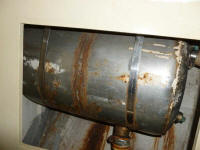
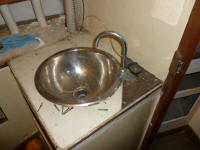
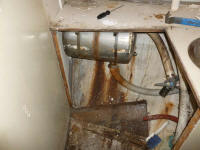
After removing one of the straps securing the tank, and loosening the second, I carefully threaded the long hose attached to the bottom outlet--which led up through the countertop past the sink and (formerly) to the deck discharge outlet--down through the countertop, hoping to keep it above the level of the tank to avoid discharge of any contents. I'd just about succeeded when the hose simply came off the tank outlet; the ancient, corroded clamp simply wasn't gripping much anymore. This was not what I had hoped would happen, and it turned out the tank was full (of salt water and antifreeze, I desperately told myself, but...well, we will speak of this no more).
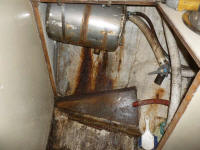
Helpless to do anything but watch in mute horror, I waited till the tank had glugged its final breath, then removed it and, as expeditiously as possible, transported it to the dumpster. One of the other hoses came off on its own in this process, so clearly this tank had been multiple disasters waiting to happen. Throughout this process, I wore gloves and washed my hands frequently.
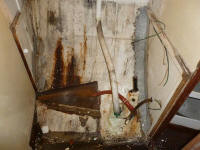
I'd not planned to reintroduce water to the boat just yet, though with the condition of the bilges I knew that I'd be soaking them at some point; with the problems in the head, however, I had no choice but to wash things down. I allowed some of what spilled to come out through the bilge drain plug, which was open, but then I installed a plug made up of a couple things I had on hand (the original plug was nowhere to be found) and fill the bilge with soapy water to let it soak for a while--the first of several cleaning steps required for the greasy (and otherwise nasty) bilge.
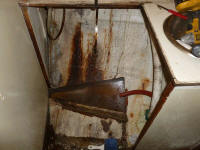

With things cleaned up a bit, I removed the remaining cabinetry, countertop, upper shelf, and plumbing, leaving only the corroded through hulls for later removal.
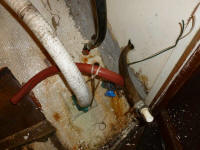
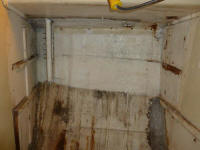
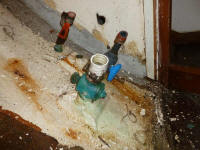
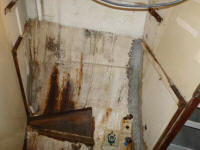
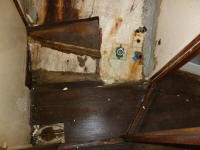
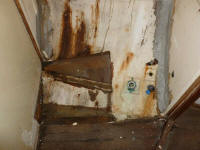
After drying things up a bit, I removed several small remaining pieces of trim from the passageway and forward cabin, more or less completing the interior disassembly for now. I also removed a stainless steel water tank from beneath the forward part of the V-berth; this tank had not been connected to anything and was not attached in any way, so it came out with ease.
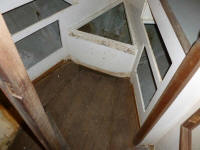
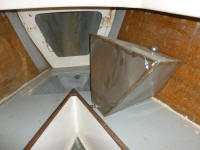
There was another water tank beneath the starboard settee. The platform was screwed down and appeared to be removable, but I'd get to that a little later.
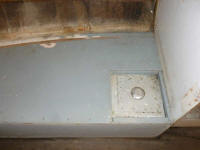
Back on deck, I removed the genoa tracks from the toerail. As was common back in the day, the track was installed on a small wooden spacer to provide the "T" shape required for cars to slide; modern tracks incorporate this shape into the track itself. There were no issues removing the tracks, though I was glad for my impact gun.
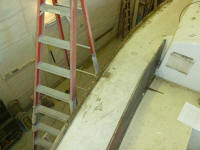
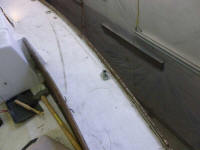
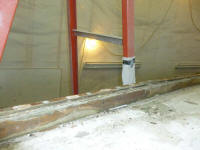
In the galley, I cut away part of the aft bulkhead so I could reach the final stanchion base fasteners, and removed the base.
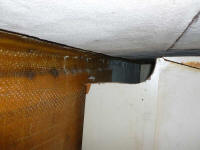
This wrapped up the major parts and hardware removal, and the boat was basically stripped to her basics. Later, I'd get those coamings off (I had a feeling it would be splinter by splinter), and it was pretty clear that the toerails would be coming off as well, but that would wait till I built some staging and till after the bottom and hull were stripped.
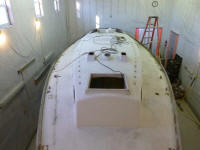
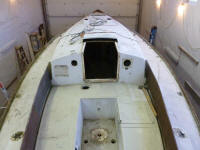
Total Time on This Job Today: 4.5 hours
